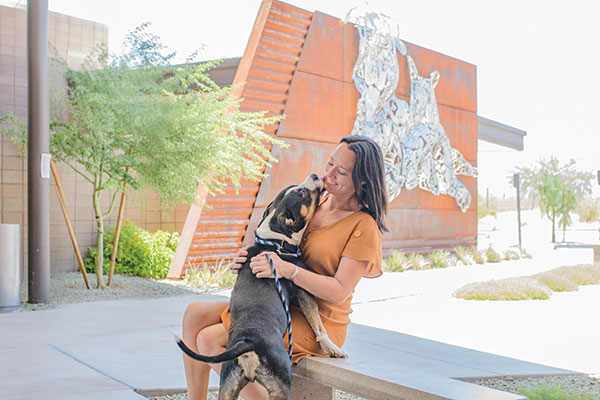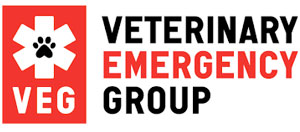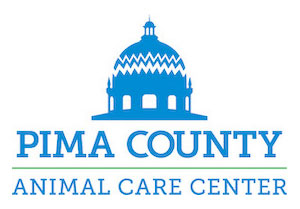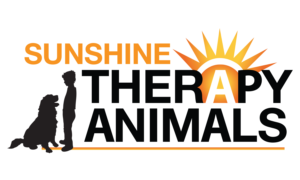Story by Rebecca West
Photos by Candice Eaton
What does it take to reinvent the wheel? The wheel, of course, in this case, is the standard model for animal shelters. Set back in 1869, the very first official animal shelter in the country was formed by the Women’s SPCA of Pennsylvania. Eight years later, in 1877, The American Humane Association formed, followed by The Humane Society of the United States in 1954.
It should come as no surprise, then, that a woman is re-setting the standard here in Tucson in the 21st century. That woman is Kristen Hassen-Auerbach, Director of Animal Services at PACC since July 2017. Over a mere three years, Hassen-Auerbach has managed to set a course for progress and get a lot done — and we mean A LOT. That includes personal accomplishments, but even those have a direct bearing on the facility and the animals whose welfare she’s charged with overseeing.
In November 2018, just 18 months after she arrived at PACC, she was recognized at the Executive Excellence Awards for her work, receiving the prize for Executive Level Department Leader of a Large or Nonprofit Company. She graciously dedicated her win to all of the dogs and cats at PACC while thanking the community for their support in her acceptance speech.
But her efforts have paid off in a far more significant manner than recognition for a job well done. For instance, when Hassen-Auerbach began with Pima Animal Care Center, the number of euthanasias per year was high but not out of line with the rest of the country. That didn’t matter to her. What mattered was reducing the numbers drastically to fall into line with a no-kill status, and that’s just what she did.
National organizations com-monly define the threshold for a No Kill community to be 90 percent. That means that 90 percent or more of the animals entering shelters and rescues in a community exit the way they came in: alive. According to pima.gov, in 2008, more than 25,000 cats and dogs were admitted to the shelter, and less than half made it out alive. These are sobering statistics.
“Just nine years ago, 15,000 pets were euthanized. Today, we’d consider that unacceptable and entirely unnecessary,” Hassen-Auerbach declared.
When she began in 2017, PACC was nearing completion of a major renovation project that would see many improvements and upgrades to the facility. The original compound, constructed in 1960, when PACC was designed to be a dog pound and strays were held for a measly three days, and unclaimed canines were routinely euthanized, was never built to save the majority of its residents.
As time went on and the community grew, the small size of the original structure led to even higher numbers of pets being euthanized just to compete for space with incoming animals. In 2014, the Pima County Board of Supervisors and taxpayers voted to provide funding for a new shelter. The difference this time was that it was expressly designed for the purpose of saving lives.
The new facility features a state-of-the-art medical clinic, which includes isolation spaces for various treatable sicknesses. There is indoor/outdoor group housing for adult and juvenile felines, 11 play yards for dogs and puppies, indoor/outdoor kennels for canines, visitation rooms, a volunteer center, a real-life room, and behavior and enrichment center.
Plus, there’s Pet Central, a well-appointed pet shop on site where visitors can purchase supplies they might need for not only transporting their new pet home but keeping them com-fortable and happy once they arrive. Fifty percent of the store’s proceeds go to Friends of PACC, their tireless support arm.
If you’ve ever been to PACC and visited its kennels you’ve likely been struck by the calm within. Unlike many, if not most shelters around the country, there is no cacophony of constant barking and high-pitched whining. Also absent is the high level of stress that is normally so palpable in these settings. The boarding areas are clean, well lit, and free of odor. It’s the way all shelters should be — if we have to have them.
And unfortunately, we still do, but Hassen-Auerbach is determined that the numbers will shrink significantly, and she’s accomplishing this through fostering. On any given day, PACC has, on average, 1,000 animals in its care. Sometimes the numbers can be as low as 300-400 or as high as 1,500.
In 2018, 5,000 of the animals delivered to PACC avoided staying there for any real length of time through the generosity of foster care. In 2019, the numbers inched up with 5,244 pets receiving a reprieve from shelter life through fostering. This year, with the coronavirus throwing everything into chaos, the shelter saw an unprecedented flood of foster applications that nearly emptied the shelter.
Many of these COVID cuddlers will likely be adopted and remain in their new forever homes, but how do you get these types of results when there’s not a pandemic or national disaster afoot? The answer lies with the health and welfare of the community.
“We need to be proactive and work with the community. If we do, we can keep these pets in their homes where they belong rather than being surrendered. Part of the reason we saw so many animals around the country in 2008, ’09, and ’10 ending up in shelters was due to their owners no longer being able to care for them. If we can help people who are struggling for whatever reason we can avoid their pets ending up here,” Hassen-Auerbach reflected.
And the reasoning is sound. When people’s lives start falling apart, whether through diminished income, illness, depression, etc., they find themselves struggling just to function and survive. While maintaining the presence of their pets is probably the best thing for them and the animals, that just isn’t how it always works out.
“This year, we’re upping our efforts through outreach to both the community members in need, but also the members who can help make a difference. They include community stakeholders, volunteers, foster and rescue partners. They are the engine that keeps PACC running, the thousands of people that make it what it is. And it really is a labor of love by the entire community. It just shows what it means when they say “it takes a village,” she stated.
Last year, Hassen-Auerbach, her staff, and the community managed to save 92 percent of the animals housed, and their goal of becoming the largest municipal foster program in the country was reached. But there’s still more to be done.
“My vision for PACC is that the vast majority of our animals are entered into foster care — which is a far healthier environment for them than even the best shelter — and that only the animals that truly need our assistance are housed here until we can get them better and find them homes. They might have health issues that need to be addressed that are beyond the scope of the foster giver. They might even have behavioral issues that need to be initially dealt with until we can find them the right environment. But the long-term goal is to only house on-site the animals that require our help the most,” Hassen-Auerbach added.
Some of the features that are being implemented include an increase in remote services, like telehealth and texting options for pet owners to take advantage of. As Hassen-Auerbach stresses, when people struggle, animals struggle, so they want to do whatever they have to to keep the community safe.
While they’ll continue to be open seven days a week, other features will be in play, such as adoption counseling via Zoom, a pet support call center and community outreach clinic.
When asked about her influences, Hassen-Auerbach noted that it is rooted in all of the work done in human support services and social work. She also pointed to The 10 Elements of the Animal Social Services Model, which can be viewed on American Pets Alive!, the nation-wide educational program of Austin Pets Alive!
That takes us back to Hassen-Auerbach’s early work in animal welfare. After graduating from Ohio State University in 2005 with a Masters in comparative cultural studies and homelessness & gentrification, she became the activities coordinator with Huckleberry House, a facility working with Central Ohio’s youth and families dealing with difficult problems.
By 2012, she had become the program manager for the Fairfax County Park Authority in Virginia. That led to her serving as the government’s Interim Director of an open-access, municipal shelter with an annual intake of 4,500 animals in Northern Virginia. In this role, she planned and implemented changes that resulted in Fairfax County’s live release rate of animals exceeding 90 percent!
From there, she made her way to Austin, Texas, where she eventually became the Deputy Chief Animal Services Officer overseeing operations for Austin Animal Center, then America’s largest No Kill, open admissions municipal shelter. The center sees 18,000 animals coming through its doors each year, and through its partnerships, they are able to save more than 95 percent of Austin’s homeless pets. After two years there, it was on to Arizona.
Since her time in Tucson and joining PACC, she’s become an Adjunct Instructor at the College of Public Health through the University of Arizona. The goal there is engaging undergraduate and graduate students in helping to create data-driven strategies for lifesaving and community engagement in relation to homeless pets. So, she’s obviously no slouch and has the credentials and the chops to back it up.
We asked her what drew her to Tucson and what else she credits her success in the area to. Her reply was that Tucson, like San Francisco and a number of other cities in the U.S., has a vibrant community filled with persons committed to animal welfare. She feels it’s also why PACC’s efforts have been so successful when it comes to adoption and foster rates, which in turn have led to lower kill rates.
“I really can’t stress enough the gratitude we have for the hundreds of supporters who have come to our aid. Without them, we could never have achieved this. It gives us all hope. The work is an evolving, life-long endeavor, and we’re committed to it. We’re basically ‘The Little Engine that Could’. We now lead the nation in human/animal support services, and we’re just so proud of how far PACC has come.”
While we were there, Deputy Director Monica Dangler was kind enough to give us a tour of the campus, and we were able to speak with other staff members and volunteers along the way. Everyone, regardless of the number of months/years there, felt it was the place they were meant to be. Their admissions staff are super sleuths working hard to reunite lost pets with their owners. When that fails, they work equally hard to find suitable matches for the animals, whether it be permanent or temporary.
And like Hassen-Auerbach, their goal is to keep pets and families together. If/when that fails, which they’re hoping to see far less of as the program continues to grow, then it’s all about a happy ending for the animals and their new families in a forever home where they will not just survive but thrive. And in the end, isn’t that what it’s really all about?













